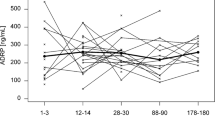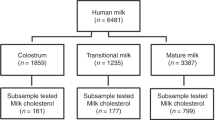Abstract
Objective: Milk triglycerides from colostrum, transitional and mature human milk, were analyzed and compared in order to determine the differences in triacylglycerol composition throughout lactation.
Setting: Department of Food and Nutrition, University of Barcelona, Spain, and Neonatology Department of the University Hospital of Granada, Spain.
Subjects: Twenty-two healthy lactating women aged 21–35.
Design and interventions: The triacylglycerol profiles of 47 breast milk samples including colostrum (1–3 days), transitional milk (7–10 days) and mature milk (25–60 days) were analyzed by high-performance liquid chromatography (HPLC), with light-scattering detection (LSD).
Results: Significant differences regarding several triglycerides were found between three milk classes when the Kruskal–Wallis nonparametric test was applied to 47 human milk samples that had been compared using the complete chromatographic triacylglycerol profile. The ANOVAS for each equivalent carbon number (ECN) group of triglycerides revealed significant differences between colostrum, transitional milk and mature milk. By the discriminant analysis of triacylglycerol percentages, in 19 colostrum samples, 14 transitional milk samples and 14 mature milk samples, three milk types were distinguished, and three triglycerides (peak no. 4, LnOO and SOO) were found to be the most predictive variables over all the triacylglycerol profile or ECN groups.
Conclusions: Each state of lactation shows a specific profile of triacylglycerol composition in human milk. However the two most abundant triacylglycerides in colostrum, POO and POL, which account for more than 49% of the total, are also dominant in transitional (34%) and mature milk (42%).
Sponsorship: CeRTA (Centre de Referència en Tecnologia d’Aliments) supported this study.
European Journal of Clinical Nutrition (2000) 54, 878–882
This is a preview of subscription content, access via your institution
Access options
Subscribe to this journal
Receive 12 print issues and online access
$259.00 per year
only $21.58 per issue
Buy this article
- Purchase on Springer Link
- Instant access to full article PDF
Prices may be subject to local taxes which are calculated during checkout
Similar content being viewed by others
Author information
Authors and Affiliations
Corresponding author
Rights and permissions
About this article
Cite this article
Morera Pons, S., Castellote Bargalló, A., Campoy Folgoso, C. et al. Triacylglycerol composition in colostrum, transitional and mature human milk. Eur J Clin Nutr 54, 878–882 (2000). https://doi.org/10.1038/sj.ejcn.1601096
Received:
Revised:
Accepted:
Published:
Issue Date:
DOI: https://doi.org/10.1038/sj.ejcn.1601096
Keywords
This article is cited by
-
Biotechnological and Novel Approaches for Designing Structured Lipids Intended for Infant Nutrition
Journal of the American Oil Chemists' Society (2017)
-
A comparative study of the composition of triacylglycerol molecular species in equine and human milks
Dairy Science & Technology (2012)
-
Breast Milk Excretion Kinetic of β-HCH, pp′DDE and pp′DDT
Bulletin of Environmental Contamination and Toxicology (2009)
-
Triacylglycerol markers of mature human milk
European Journal of Clinical Nutrition (2003)



